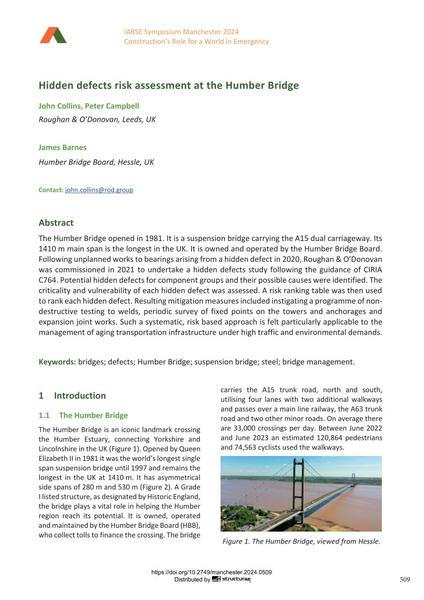Hidden defects risk assessment at the Humber Bridge

|
|
|||||||||||
Bibliographic Details
| Author(s): |
John Collins
(Roughan & O’Donovan, Leeds, UK)
Peter Campbell (Roughan & O’Donovan, Leeds, UK) James Barnes (Humber Bridge Board, Hessle, UK) |
||||
|---|---|---|---|---|---|
| Medium: | conference paper | ||||
| Language(s): | English | ||||
| Conference: | IABSE Symposium: Construction’s Role for a World in Emergency, Manchester, United Kingdom, 10-14 April 2024 | ||||
| Published in: | IABSE Symposium Manchester 2024 | ||||
|
|||||
| Page(s): | 509-517 | ||||
| Total no. of pages: | 9 | ||||
| DOI: | 10.2749/manchester.2024.0509 | ||||
| Abstract: |
The Humber Bridge opened in 1981. It is a suspension bridge carrying the A15 dual carriageway. Its 1410 m main span is the longest in the UK. It is owned and operated by the Humber Bridge Board. Following unplanned works to bearings arising from a hidden defect in 2020, Roughan & O’Donovan was commissioned in 2021 to undertake a hidden defects study following the guidance of CIRIA C764. Potential hidden defects for component groups and their possible causes were identified. The criticality and vulnerability of each hidden defect was assessed. A risk ranking table was then used to rank each hidden defect. Resulting mitigation measures included instigating a programme of non- destructive testing to welds, periodic survey of fixed points on the towers and anchorages and expansion joint works. Such a systematic, risk based approach is felt particularly applicable to the management of aging transportation infrastructure under high traffic and environmental demands. |
||||
| Keywords: |
steel bridges suspension bridge bridge management defects Humber Bridge
|
||||
